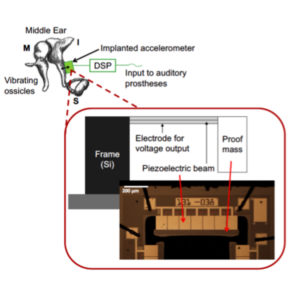In this application, we seek to design, fabricate, and test implantable, packaged accelerometers that sense incoming sound by transducing the motion of the middle ear (ME) bones (ossicles). We will test the performance of these devices using benchtop calibration and quantification tests as well as using acoustic stimulation of accelerometers implanted in cadaveric temporal bone preparations. We seek to create a device that meets the stringent geometric, acoustic, weight, and power requirements for prostheses by using a multi-resonant (multi-band) piezoelectric-micro-electro-mechanical systems (piezo-MEMS) sensor co-designed with an application specific integrated circuit (ASIC) with addressable filtering and amplifying circuitry.
A novel flip-chip packaging strategy is proposed which can deliver a 5-milligram piezo-MEMS-ASIC packaged device by eliminating the need for printed circuit board mounting. State-of-the-art thin piezoelectric film materials and deposition will be explored to further reduce the device size and improve performance. Separate, component-level piezo-MEMS die and ASIC testing in combination with system-level testing in a benchtop setting will enable characterization of the complete system.
Tested sensor systems will be implanted in male and female cadaveric temporal bone samples, and the acoustic sensitivity and noise floor characterized. While the umbo will be used for initial cadaveric tests, we will consider alternative locations along the ossicular chain to reduce device impact on the ME mechanics, ease surgical implantation (minimize invasiveness), and maximize sensitivity (as the accelerometer is sensitive to both translation and rotation).
The objective of this present application is to develop implantable sensors, because accomplishing this objective is a necessary step in achieving our long-term goal of a totally implantable auditory prosthesis (e.g., hearing aids and cochlear implants with all components housed invisibly). This line of research aims to provide new implantable options to treat hearing loss, thereby increasing the number of auditory prosthesis users by enhancing the usability, safety, cosmetic appeal, and performance of the device and improving patient quality of life.
People
Funding

Funding: $30K (2022)
Goal: The goal of this project is to create an completely implantable auditory prostheses replacing all external components of both hearing aids and cochlear implants.
Token Investors: Karl Grosh, David Wentzloff
Project ID: 1053



